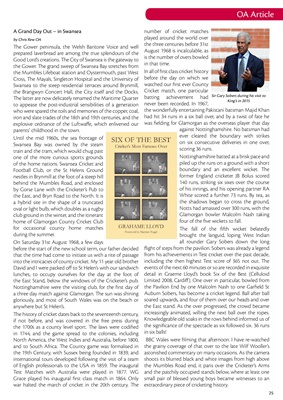
A Grand Day Out - in Swansea
by Chris Rew OA
he Gower peninsula, the Welsh Baritone Voice and well
prepared laverbread are among the true splendours of the
Good Lord's creations. he City of Swansea is the gateway to
the Gower. he grand sweep of Swansea Bay stretches from
the Mumbles Lifeboat station and Oystermouth, past West
Cross, he Mayals, Singleton Hospital and the University of
Swansea to the steep residential terraces around Brynmill,
the Brangwyn Concert Hall, the City itself and the Docks.
he latter are now delicately renamed the Maritime Quarter
to appease the post-industrial sensibilities of a generation
who were spared the toils and memories of the copper, coal,
iron and slate trades of the 18th and 19th centuries, and the
explosive ordnance of the Luftwaffe, which enlivened our
parents' childhood in the town.
Until the mid 1960s, the sea frontage of
Swansea Bay was owned by the steam
train and the tram, which would chug past
one of the more curious sports grounds
of the home nations. Swansea Cricket and
Football Club, or the St Helens Ground
nestles in Brynmill at the foot of a steep hill
behind the Mumbles Road, and enclosed
by Gorse Lane with the Cricketer's Pub to
the East, and Bryn Road to the North. It is
a hybrid site in the shape of a truncated
oval or light bulb, which doubles as a rugby
club ground in the winter, and the itinerant
home of Glamorgan County Cricket Club
for occasional county home matches
during the summer.
On Saturday 31st August 1968, a few days
before the start of the new school term, our father decided
that the time had come to initiate us with a rite of passage
into the intricacies of county cricket. My 11 year old brother
David and I were packed off to St Helen's with our sandwich
lunches, to occupy ourselves for the day at the foot of
the East Stand, below the windows of the Cricketer's pub.
Nottinghamshire were the visiting club, for the first day of
a three day match against Glamorgan. he sun was shining
gloriously, and most of South Wales was on the beach or
anywhere but St Helen's.
he history of cricket dates back to the seventeenth century,
if not before, and was covered in the free press during
the 1700s as a county level sport. he laws were codified
in 1744, and the game spread to the colonies, including
North America, the West Indies and Australia, before 1800,
and to South Africa. he County game was formalised in
the 19th Century, with Sussex being founded in 1839, and
international tours developed following the visit of a team
of English professionals to the USA in 1859. he inaugural
Test Matches with Australia were played in 1877. WG
Grace played his inaugural first class match in 1864. Only
war halted the march of cricket in the 20th century. he number of cricket matches
played around the world over
the three centuries before 31st
August 1968 is incalculable, as
is the number of overs bowled
in that time.
In all of first class cricket history
before the day on which we
watched our first ever County
Cricket match, one particular
batting achievement had
never been recorded. In 1967,
the wonderfully entertaining Pakistani batsman Majid Khan
had hit 34 runs in a six ball over, and by a twist of fate he
was fielding for Glamorgan as the overseas player that day
against Nottinghamshire. No batsman had
ever cleared the boundary with strikes
on six consecutive deliveries in one over,
scoring 36 runs.
Nottinghamshire batted at a brisk pace and
piled up the runs on a ground with a short
boundary and an excellent wicket. he
former England cricketer JB Bolus scored
140 runs, striking six sixes over the course
of his innings, and his opening partner RA
White scored a further 73 runs. By tea, as
the shadows began to cross the ground,
Notts had amassed over 300 runs, with the
Glamorgan bowler Malcolm Nash taking
four of the five wickets to fall.
he fall of the fifth wicket belatedly
brought the languid, loping West Indian
all rounder Gary Sobers down the long
flight of steps from the pavilion. Sobers was already a legend
from his achievements in Test cricket over the past decade,
including the then highest Test score of 365 not out. he
events of the next 60 minutes or so are recorded in exquisite
detail in Graeme Lloyd's book Six of the Best (Celluloid
Limited 2008, Cardiff). One over in particular, bowled from
the Pavilion End by one Malcolm Nash to one Garfield St
Auburn Sobers, has become a cricket legend. Ball after ball
soared upwards, and four of them over our heads and over
the East stand. As the over progressed, the crowd became
increasingly animated, willing the next ball over the ropes.
Knowledgeable old soaks in the rows behind informed us of
the significance of the spectacle as six followed six. 36 runs
in six balls!
BBC Wales were filming that afternoon. I have re-watched
the grainy coverage of that over to the late Wilf Wooller's
astonished commentary on many occasions. As the camera
shoots its blurred black and white images from high above
the Mumbles Road end, it pans over the Cricketer's Arms
and the patchily occupied stands below, where at least one
small pair of blessed young boys became witnesses to an
extraordinary piece of cricketing history.
25
OA Article
Sir Gary Sobers during his visit to
King's in 2015